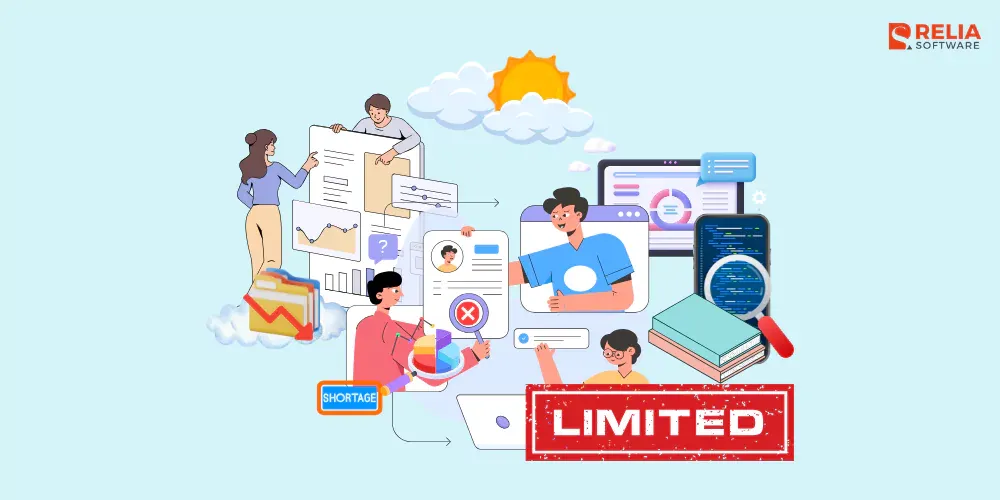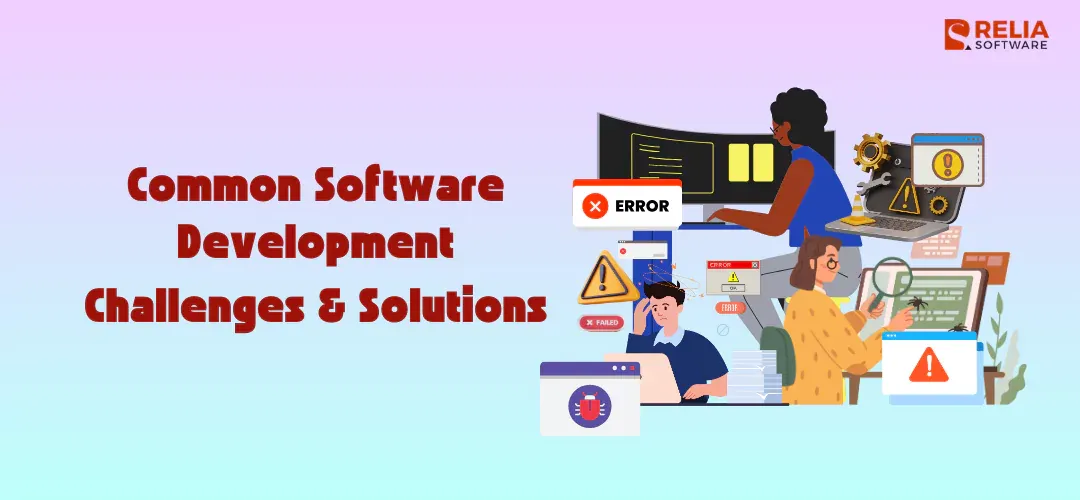Software development is not an easy process. It has to integrate both the technical skills of developers and organizational efforts. Whether problems are with scope creep, security risks, or anything else that could affect the project, developers and managers have to deal with these risks and problems effectively to ensure the quality of the project.
This article shows the 10 most common software development issues and their solutions. Whoever you are, as software project management, developers, and business stakeholders working on the project, will benefit from the following information.
Unclear Project Goals and Objectives
Uncertain project scope is the major issue with software development. A lack of clear objectives makes the targets unattainable, the direction of a project unclear, and the risks involved not well forecasted. These problems lead to inefficiency in the software development process and are less prominent compared to competitors, hence the project's failure.
Solutions:
- Set Clear KPIs and Milestones: Avoid confusing the team’s members by stating clear goals. For example, cut the cart abandonment rate by 10% or enhance page load by 20%.
- Align Goals Across Teams: Schedule a meeting with all stakeholders and team leaders to align the technical and business goals of each team. It also provides coordination and guarantees that all work is directed towards the achievement of the project.
- Continuously Validate Goals: Ensure that the overall goals of the project are going through constant review and update with references to the achievement of the overall goals of the project.

>> Read more: Product Metrics in Software Engineering
Scope Creep and Changing Requirements
Scope creep is when the project requirements expand beyond the plan objectives that have been set in the beginning. It results in increased time-completion, cost overruns, and late time-to-market. Changed requirements—either from a client or as a result of market fluctuations—can intervene and destabilize the process and basic objectives of a project.
Solutions:
- Define a Clear Scope: Work with stakeholders to agree on specific objectives for your project. Defining what is in and out of the project's scope in a detailed requirement document. Some of the tracking tools include traceability matrices that will help in controlling changes to follow the initial plan.
- Adapt to Changing Needs: Employ Agile approaches to be flexible and adapt to iterative development. New requirements validation can be done using prototypes, while contingency plans guarantee smooth progress in the case of changes.
- Communicate Transparently: Inform related stakeholders which activities change in the project scope. Clear reports and documentation make it easier to minimize misunderstandings, thus keeping everyone on task.
- Manage Budget Smartly: It is also helpful to use project accounting software to track budgets, expenses, and financial progress during the planning phase.
>> Read more:
- Prototype Model in Software Engineering
- The Differences Between Proof of Concept (PoC) vs Prototype
Communication Barriers and Misinterpreted Needs
Effective communication is important in software development. Some common problems when developing applications result from misunderstandings among developers, stakeholders, or clients. It leads to incorrect implementations, project delays, team frustration, etc. Lack of communication can also lead to unattended conflict and strained relationships in the team, which will definitely compromise the projects.
Solutions:
- Clear Communication Channels: To avoid the project getting off track and minimize the risks, the management needs to frequent team meetings, prepare weekly status reports, and conduct project quality reviews. Make sure that team members have nothing missed and smooth communication.
- Use Collaboration Tools: Communicate with applications like Slack, Trello, or Jira to updates on jobs offered and give feedback. Remote teams can consult through video calls and emails between different time zones.
- Promote Proactive Communication: It is vital for people on the team to be confident to ask all the questions they might need the answers to. Set up a meeting to brainstorm ideas and get input. This ensures that every part of the project is carried out smoothly and there is no deviation in the plan.

Resource Constraints
Fast software development processes often lead to a lack of human capital and other resources. Consequently, the progress can be delayed, and high possibilities of time and quality compromise. These challenges are worse in remote working environment settings since coordination and management of resources are more difficult.
Solutions:
- Hire and Retain Top Talent: Make a solid recruitment procedure by providing reasonable wages, attractive benefits, and a positive working environment. Businesses should employ diversity and inclusion to incorporate more people to work and improve creativity from different viewpoints.
- Upskill Your Team: Provide links to online courses, certifications, and workshops. There should be well-articulated professional training sessions so that the team can be updated on the most current advances.
- Leverage Outsourcing: Overcome resource constraints by subcontracting certain roles that require specialists or specific skills. This can provide value by being cheap for resource-intensive tasks.

>> Read more:
- A Comprehensive Guide to Software Development Outsourcing
- What to Look for in An Outsourced Software Development Company?
- Software Development Outsourcing for Startups, SMBs, SMEs
- An In-Depth Guide To Hire Remote Developers
- Top 10 Best Countries for Outsourcing Software Development
- Top 10 IT Outsourcing Companies in Vietnam
Keeping Up with Evolving Technologies
The fast-growing speed of technology puts development teams under pressure to adapt to new tools, languages, and frameworks. Not regularly updating can cause an organization to lag behind in technology and lose good niches in stiff market competition.
Solutions:
- Encourage Continuous Learning: Continuously training employees with online courses, certifications, and other workshops in new technologies such as AI, blockchain, and cloud-native development. It makes your team remain at the cutting edge of technology meanwhile also helping to advance your company’s digital transformation.
- Adopt New Tools and Frameworks: Become open to technology resources and processes that improve productivity and effectiveness. Use change management to define how to avoid resistance and to manage transitions easily. IT infrastructure should be updated regularly to meet organizational needs and to counter the problem of obsolescence.
- Monitor Industry Trends: Keep track of artificial intelligence (AI), cloud computing, DevOps, and Agile practice trends. It is important to review your tech stack and market position to consider possibilities for optimization. Most customers would prefer to work with a technologically advanced company over their less innovative ones in the market.

>> Read more:
- Top 12 Web Development Trends to Watch
- Top Mobile App Development Trends
Integration Issues with Third-Party Systems
Integrating third-party systems like APIs or services is not easy because of dealing with compatibility problems and escalation of system complexities. Inefficient integration can result in interupt and problems in the flow of operations as well as the functionality of the system.
Solutions:
- Ensure Compatibility: Review and explore where to integrate third-party systems to ensure that they fit into your architecture. To avoid different systems unable to compete, request handling should be facilitated through middleware or API gateway components.
- Follow Best Practices: In this case the integration could be achieved using standardized integration frameworks. Use mapping to ensure that all the data in the systems match. In SOA or microservices, you should have good documentation to support the interactions between services.
- Test Before Deployment: Carefully do test runs in a pre-production environment to check product efficiency in a staging environment. Also, use CI pipelines together with automation tests to detect errors at an early stage. For the integration of two applications, it is necessary to incorporate error-handling mechanisms and retry systems so that they do not influence overall effectiveness.
Testing Challenges and Ensuring Code Quality
Testing is always a critical part of developing software, but its significant drawback is using a lot of resources, in particular if the code base is large. Every time proper testing is ignored, there are likely to be hidden bugs, performance problems, and low-quality code affecting production and users.
Solutions:
- Use Automated Testing: Use automated testing techniques to complete the survey early so that developers can recognize any problems as soon as possible. You should group unit, integration, and performance tests together for an optimum result. Automation tests can guarantee that everything is tested before deployment.
- Adopt Test-Driven Development (TDD): Use TDD to provide tests before writing the code to make certain that it fulfills the needs out of the gate. Combine it with other technology code checkup systems like Linters to help keep code standards and top-level detect problems. This approach enhances code quality by reducing technical problems and thereby minimizes technical debt.
>> Read more:
- Software Testing Life Cycle (STLC)
- Detailed Explanation of 7 Software Testing Principles
- A Guide to Functional Testing for Ensuring Flawless Software
- A Comprehensive Guide to Non-Functional Testing (NFT)
- Top 20 Open-Source Unit Testing Frameworks For Developers
- Top 7 Best Performance Testing Tools for Developers
Security Vulnerabilities and Data Protection
Security is very important in software development because breaches can cause money loss, legal issues, and damage to reputation. If there are no strong cybersecurity measures, systems can be weak against threats that harm data privacy and integrity, putting both organizations and users at risk.
Solutions:
- Use the Best Security Practices: Regularly check security, do penetration tests, and follow safe coding practices to find and fix weaknesses early. Use threat detection tools and create a plan to respond quickly to cyberattacks.
- Security at Every Phase: Integrate security measures through the development lifecycle from design to deployment. Apply data encryption and cryptographic methods in the storage of sensitive information both in rest and transit. Breach risks are reduced by an approach of "security by design."
- Make Sure to Follow Rules: Stay in line with standards like GDPR, HIPAA, or CCPA by putting in place necessary protections. Use monitoring tools to watch for possible violations and update privacy policies often to keep up with changing legal and industry needs.
>> Read more:
- What is Security Testing in Software Testing?
- Top 7 Web App Security Testing Tools For Developers
- Top 14 Best Data Security Software For Your Businesses
Deployment and Maintenance Difficulties
The most critical parts of software development progress are the deployment and post-launch maintenance phases. Not using good deployment methods can make the application unavailable, have mistakes, and face technical problems. Also, if maintenance is not done well, it will make the software less productive, leading to a gradual decrease in customer satisfaction.
Solutions:
- Easier Deployment: The automation tools decrease the number of errors and facilitate continuous deployment plans. Testing the deployment pipelines in different environments through IaC tools ensures that the platform remains consistent. In addition, the system is more reliable and productive since fewer tasks are performed manually.
- Plan for Ongoing Maintenance: Make a clear plan for maintenance tasks, like regular updates, fixing bugs, and checking performance. Using release management and version control to keep different versions of the software. This helps keep applications up to date, meets user needs, and improves over time.
- Emphasize Continuous Improvement: The performance is monitored in real-time through application monitoring tools, and problems in operation are addressed early. Incident reports and maintenance of root cause analysis to prevent the recurrence of the same problem. Create a database to capture users' feedback and then use it in updating the software frequently to meet current user experience and technological developments.
>> Read more:
- Top 9 Best DevOps Deployment Tools for Businesses
- A Comprehensive Guide To On-Premise Deployment
- Cloud vs On Premise Deployment: Similarities and Differences
Tight Deadlines and Quality Assurance
Meeting deadlines and quality assurance (QA) on software projects often causes great difficulties for project managers. When developers work under a tight schedule and in a hurry to complete tasks in the given time, various issues are taken as technical debt, low product quality, and long-term maintenance problems. These can affect the app performance and user satisfaction.
Solutions:
- Adopt Effective Time Management: Divide the big task into many small achievable and measurable milestones, then organize them through Agile sprints. Sprint retrospectives should be used to review progress and adjust the timelines within the value stream. This ensures a smooth operation while providing the elasticity required to change plans or resources.
- Maintain Speed Without Sacrificing Quality: Use automated testing and CI/CD pipelines to catch bugs and fix them without slowing development speed. Do performance tests and keep track of KPIs to ensure the software meets quality requirements even under tight deadlines.

Conclusion
It is very important to address these above software development challenges to ensure that project outcomes are successful. By adhering to the solutions we have outlined above, software development will become less burden. Continuous learning, good communication, and quality focus are the main keystones that can help an individual overcome these barriers and be successful in the volatile world of software.
>>> Follow and Contact Relia Software for more information!
- development
- web development

